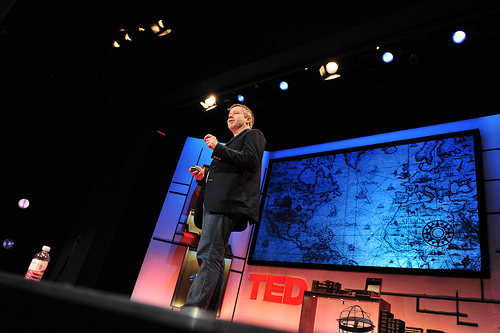
Tim Brown at TEDGlobal 2009, Session 7: July 23, 2009, in Oxford, UK. Credit: TED / James Duncan Davidson
Designer Tim Brown of IDEO begins his talk by posing the question, “What happens if you move from design to design-making?” He sees a profound difference between the two. He explains that when he first began working as a designer he had a small view of design. He shows his first projects: a woodworking machine and a fax machine. In both cases, he put a prettier casing around an existing object and in both cases the companies were out of business within months.
He thinks that his small view was influenced by more recent trends in design. But, he says, design used to be big. He shows a slide of Isambard Brunel, and introduces him as one of the great designers. Brunel was responsible for the Great Western Railway and wanted to achieve for passengers the experience of floating across the countryside, which meant creating flattest gradients ever. He imagined an integrated transportation system where a passenger could embark on a train in London and take that straight through to a ship to New York City.
Brown explains that design thinking begins with integrative thinking. Opposing ideas and opposing constraints create new solutions. It’s a matter of balancing desirabilty with feasibility and viability. But then, he says, design became a priesthood of black turtlenecks and designer glasses focusing on an ever smaller campus and creating pretty but not necessarily useful objects.
Today, he thinks design is beginning to think big again. Design has returned to being human-centered, meaning that it starts with what humans need, which is more than good ergonomics. Brown expands by saying that good design is often about understanding culture and context.
Then he describes the main characteristics of good design-making. First, he says, one must begin learning my making and building in order to think. Prototypes speed up the process of innovation. One has to put products into the world to see their successes and failures. Then, instead of making our primary objective consumption, we must see it as participation. Brown thinks the design of participatory systems is going to be the major theme for design and for our economy. Design has greatest impact when put in the hands of everyone. At this point, Brown gives an example of nurses at Kaiser Permanente designing new system to increase patient comfort using in-depth conversations with the patients.
Now, Brown returns to speak about Brunell. He says that connection is change and that in times of change we need new alternatives and new ideas. Brunell proposed change in the industrial age. Industrial systems have run their course and we need another massive change. We need new choices. Design thinking gives us a new way of tackling problems. It takes a divergent approach that allows us to explore new ideas.
What is the question we’re answering today? Brown explains that he’s also working on safe drinking water for the world’s poorest, along with Acumen Fund. He teamed designers with eleven water experts across India. Then, they hosted a competition and had winners develop their ideas. The solutions were participatory and Brown thinks we can continue to use models like these to tackle bigger and more interesting questions.
Comments (1)